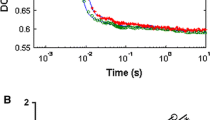Summary
The distribution of H+ between red cells and plasma was studied in the venous blood of infants and children under standardized conditions (fully oxigenated, pCO2 40 Torr, 37°C). The results obtained from 68 healthy subjects were computed to give the following regression equation: cH+ cells (nM/L)=1.068 cH+ plasma (nM/L)+25.829. No significant difference in slope was observed between the various age groups; but at a plasma pH 7.4, ΔH+showed decreasing values during infancy (1–100 days of age: ΔH+=32 nM; 101–365 days: ΔH+=29 nM; 2–14 years; ΔH+=26 nM). The distribution ratio “rH+” (H+ plasma/H+ cells) in normal children, adults and individuals with metabolic acid-base disorders (n=43) was related to the plasma pH as rH+=5.7689–0.6990 pHplasma. This is in agreement with the generally accepted idea of a Gibbs-Donnan equilibrium. The slight variation of rH+ in infants can be explained as a function of hemoglobin concentration (in anemias (n=15) cH+ cells=1.547 cH+ plasma+11.276).
Zusammenfassung
Im venösen Blut von Säuglingen und Kindern wurde die H+-Ionen-verteilung zwischen Erythrocyten und Plasma unter standardisierten Bedingungen (volloxygeniert, CO2-Partialdruck 40 Torr, 37° C) untersucht. Im physiologischen Bereich ist die H+-Ionenkonzentration im Erythrocyten um rund 30 nM/L größer als im Plasma. Die Differenz ändert sich gering mit dem Alter: bezogen auf einen Plasma-pH-Wert 7,4 (=40 nM H+-Ionenkonzentration/L) betrug sie bei 1–100 Tage alten Säuglingen im Mittel 32 nM, bei 101–365 Tage alten Säuglingen 29 nM und bei Kindern vom 2. bis 14. Jahr und Erwachsenen 26 nM. Die Neigung der Regressionsgeraden der Größen H+-Ionenkonzentration im Plasma (cH+ plasma) und H+-Ionenkonzentration im Erythrocyten (cH+ ery) ändert sich ebenfalls mit dem Alter. Jedoch sind diese Unterschiede nicht signifikant (die Geraden liegen innerhalb der Toleranzgrenzen der Regressionsgeraden des Gesamtkollektivs von 62 gesunden Personen, für die folgende Beziehung berechnet wurde: cH+ ery nM/L=1,068 cH+ plasma nM/L+25,829). Der Verteilungsquotient rcH+ (cH+ plasma/cH+ ery) gesunder Kinder und Erwachsener und von Personen mit metabolischer Säure-Base-Störung (rcH+=5,7689–0,6990 pHplasma) stimmt mit der allgemein akzeptierten Annahme eines Gibbs-Donnan-Gleichgewichts überein. Der gering abweichende rcH+im Blut von Säuglingen kann mit der diesem Alter zugehörigen Hämoglobinerniedrigung zusammenhängen, denn bei Anämiekranken wurde die H+-Ionenverteilung zwischen Zellen und Plasma deutlich abweichend vom Normalverhalten gefunden (bei 15 Personen mit Anämie: cHery nM/L=1,547 cH+ plasma nM/L +11,276).
Similar content being viewed by others
Literatur
Battaglia, F. C., R. E. Behrman, A. E. Hellegers, and J. D. Battaglia: Intracellular hydrogen ion concentration changes during acute respiratory acidosis and alkalosis. J. Pediat. 66, 737 (1965).
—, A. E. Hellegers, and A. E. Seeds: The differences between intracellular and extracellular hydrogen ion concentrations of adult and fetal blood. J. Pediat. 66, 743 (1965).
Bergner, R. E.: Experimentelle Untersuchungen zur Form und Funktion der Retikulozyten aus überstürzter Erythropoese. Inaug.-Diss. Tübingen 1963.
Bromberg, P. A., J. Theodore, E. D. Robin, and W. N. Jensen: Anion and hydrogen ion distribution in human blood. J. Lab. clin. Med. 66, 464 (1965).
Bubnoff, M. v., u. G. Riecker: Über die intracelluläre Wasserstoffionenkonzentration und das intra-extracelluläre Reaktionsgefälle. Untersuchungen an Erythrocyten. Klin. Wschr. 39, 23 (1961).
Deane, N., and H. W. Smith: The apparent first dissociation constant of carbonic acid in the human erythrocyte. J. biol. Chem. 227, 101 (1957).
Fitzsimmons, E. J., and J. Sendroy: Distribution of electrolytes in human blood. J. biol. Chem. 236, 1595 (1961).
Funder, J., and J. O. Wieth: Chloride and hydrogen ion distribution between human red cells and plasma. Acta physiol. scand. 68, 234 (1966).
Gleichmann, U., H. V. Stuckrad u. M. Zindler: Intracellulärer Säure-Basen- und Elektrolythaushalt. Experimentelle und klinische Untersuchungen an Erythrocyten. Z. ges. exp. Med. 139, 255 (1965).
Hilpert, P., R. Fleischmann, D. Kempe, and H. Bartels: The Bohr-effect related to blood and erythrocyte pH. Amer. J. Physiol. 205, 337 (1963).
Kaufmann, W., J. Kömpf u. F. Dürr: Wasserstoffionenkonzentration von Erythrocyten im Capillarblut bei Gesunden und Kranken mit Störungen des Säure-Basen-Gleichgewichtes. Z. ges. exp. Med. 142, 57 (1967).
Laue, D.: Ein neues Tonometer zur raschen Äquilibrierung von Blut mit verschiedenen Gasdrucken. Pflügers Arch. ges. Physiol. 254, 142 (1951).
Purcell, M. K., G. M. Still, T. Rodman, and H. P. Close: The determination of the pH of hemolyzed red cells from arterial blood. Clin. Chem. 7, 536 (1961).
Sommerkamp, H., u. K. Bomke: Zur Analyse des intracellulären Säure-Basengleichgewichts im Erythrocyten. Klin. Wschr. 42, 392 (1964).
—, K. Riegel, P. Hilpert u. K. Brecht: Über den Einfluß der Kationenkonzentration im Erythrocyten auf die Lage der Sauerstoff-Dissoziationskurve des Blutes. Pflügers Arch. ges. Physiol. 272, 591 (1961).
Author information
Authors and Affiliations
Additional information
Mit Unterstützung durch die Deutsche Forschungsgemeinschaft (Ri 92/3).
Rights and permissions
About this article
Cite this article
Riegel, K. Die Wasserstoffionen-Verteilung zwischen Erythrocyten und Plasma von Säuglingen und Kindern. Z. Kinder-Heilk. 106, 107–113 (1969). https://doi.org/10.1007/BF00476251
Received:
Issue Date:
DOI: https://doi.org/10.1007/BF00476251



